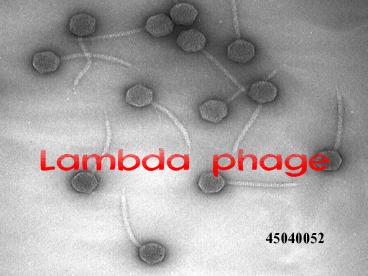Lambda phage PowerPoint PPT Presentation
1 / 34
Title: Lambda phage
1
Lambda phage
- ??? ?????????????? ???????????? 45040052
2
Lambda phage
- Order Caudovirales
- Family Siphoviridae
- Genus ?-like viruses
- Species Enterobacteria phage ?
3
Morphology
- Head icosahedral symmetry
- Tail Helical Symmetry
- one tail fiber
- Capsid not enveloped
- Linear dsDNA (phage)
- Infected E.coli cell
4
Genome
- genome contains about 50,000 nucleotide pairs
- encodes 50-60 different proteins
- Genome is 54 of virion by weight
5
- The ends of the genome have sticky ends 12 bp
long gt cos sites (cohesive ends) - The ends are joined by bacterial enzyme, Ligase
- Closed circle dsDNA (E.coli)
6
linear genome becomes circularized
7
Infected in E.coli cell
8
Life cycle of lambda phage
9
Lytic and Lysogenic phage
- Lytic pathway
- - ????????????????????????????????
- - ?????????? (cell lysis)
- - Cro promotes the lytic phase
- Lysogenic pathway
- - ?????????????????? ???? prophage
- ???? induction event ???????
- lytic pathway
- - CI promotes the lysogenic cycle
- "right" operater of lambda
10
(No Transcript)
11
Lytic cycle
- 1. Adsorption specific with
surface of the cell (outer memb.) - 2. Injection
- 3. Circulation cos site
,nuclease host - 4. Replication
bidirectional - 5. Protein coding
endonuclease plus st. - 6. Syn new minus strand and
new plus st. - 7. Lytic rolling circle
long DNA for multiple phage genome - 8. Code structeral protein ??? DNA ??? host ???
phage - 9. Packaging
- 10. Phage code endolysin destroy peptidoglycan
- Cell lysis
12
Lytic cycle
- Nick
- Rolling circle
- Polymeric genome
- Endonuclease
- Cohesive end
13
Lysogengic cycle
- ???????????
- C1 protein ???? repressor protein ??? Cro
protein ??? C1 protein ?????????????????????
promotor ?????????? Cro promotor ????? Inactivate
Cro promotor ??????????????? Lytic cycle
14
Lysogengic cycle
- Phage DNA is integrated into host chromosome at
attP site in phage genome and attB site in host
genome
15
Integration
- att an E.coli seqence for the "attachment" or
integration of lambda's circular chromosome. - oriC E.coli's origin of Chromosome replication
(given here for orientation only) - gal E.coli's gene for galactose utilization
- peprophage ends (site of integration)
- cos joined sticky ends of vegetative DNA
sometimes called ve ("vegetative ends") - int gene for the enzyme integrase
- c gene for lambda repressor to maintain lysogeny
- Q another gene concerned with lysogeny
- h the last of the many capsomer genes
16
Normal Excision lytic pathway
17
Abnormal Excision
18
??????????? ( lambda phage )
- Genetic engineering
- Specialized Transduction
19
Cosmid vector
- A sequence marked "ori" for DNA replication in
bacteria - Ampr for ampicillin selection in bacteria
- A sequence marked MCS (multiple cloning site)
that is a polylinker containing unique
restriction sites and two phage RNA polymerase
promoters (T7 and T3) in opposing directions. - Two cos sequences, separated by an Xba1 site
- An origin of DNA replication from SV40 (permits
replication and copy number amplification in many
eukaryotic cells, in the presence of SV40 T
antigen protein) - Neor for selection in eukaryotic cells with the
neomycin antibiotic analog G418
20
Genetic engineering
- Cos site
- Cosmid vector
- ( 5 kbp)
- Large flagment
- ( 35-45 kbp)
- In vitro packaging
- Select for drug resistant
21
- Insertional vector
- Replacement vector
22
Transduction Viruses are the vector as they
move genes from cell to cell.
- Specialized Transduction
- Generalized Transduction
23
Generalized Transduction A piece of host DNA
gets packaged by mistake, instead of the phage
DNA. This rare event results in a phage
delivering only bacterial DNA to the next host.
The DNA then recombines homologously, replacing
the host allele.
24
(No Transcript)
25
(No Transcript)
26
(No Transcript)
27
(No Transcript)
28
(No Transcript)
29
(No Transcript)
30
(No Transcript)
31
Specialized Transduction in which a lysogenic
prophage recombines itself out of the genome (by
site-specific recombination) and mistakenly
includes a piece of bacterial DNA. The resulting
phage progeny can infect cells to produce
lysogens with a second copy of the allele they
had packaged, attached to the phage DNA.
32
(No Transcript)
33
(No Transcript)
34
?????????

